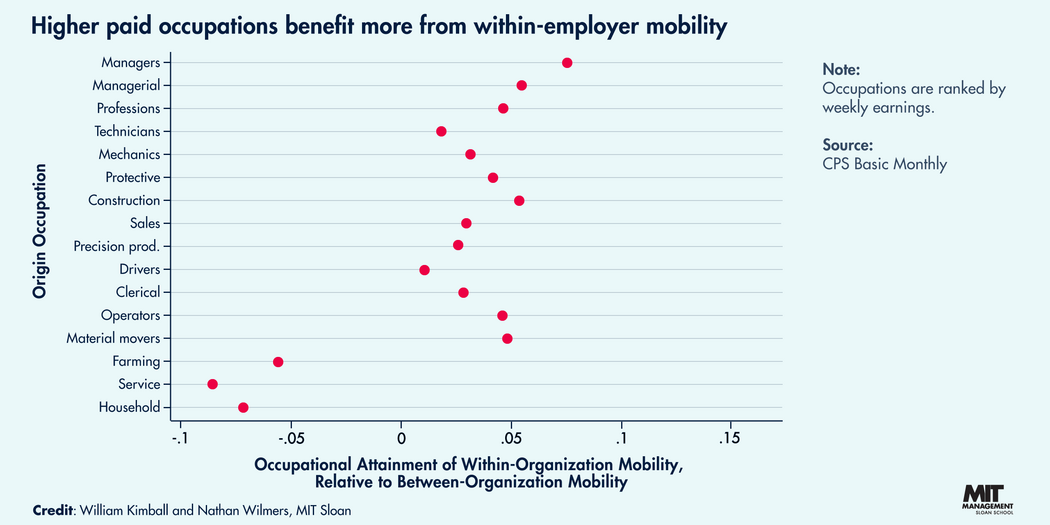Credit: a-poselenov / iStock
Gail Evans joined Eastman Kodak as a janitor in the 1980s. By the time she left the commercial print company decades later, Evans had climbed from custodial work to production assembly to software engineer — eventually serving as its chief technology officer.
But not every low wage worker has as many opportunities for upward mobility within their company. New research from MIT Sloan associate professorfinds internal hiring may not be available or advantageous for lower wage employees who most need better jobs. For those employees, making an external move can lead to better results.
“People starting out in those low-paying occupations tend to not to be in the firms that are doing internal hiring,” Wilmers said. “They tend to not be in settings where they have access to upward mobility within a firm at all, which is why they have to switch firms entirely to make progress.”
For their paper “How Internal Hiring Affects Occupational Stratification,” Wilmers and co-researcher William Kimball analyzed within-employer job switching and between-employer job switching recorded in the U.S. labor market between 1995 and 2019 using the Current Population Survey. They also surveyed respondents about informal changes in job tasks or projects (such as an architect being assigned a new building project).
The researchers found that workers in the 25% lowest paid occupations who moved to a new position within their companies earned 7% less than workers in that same wage group who switched to a new company.
Conversely, the top quarter earners received 6% more money when they made an internal move compared to those who made an external change. The reason: Higher paid workers are more likely to be exposed to opportunities for internal mobility, the researchers write, and those higher paid workers also are more likely to be in industries made up of higher-paying jobs.
It’s reasonable to think that moving up within a firm would be helpful for people who don’t have a lot of other job options, Wilmers said. These lower paid workers can prove their work ethic with a particular supervisor and with past performances, for example.
However, “If you find yourself in a low-paid occupation, you're likely working with a bunch of other people who are also in low wage occupations. Maybe there's a couple managerial positions that you could get promoted into, but it tends to be you're in a pretty occupationally homogenous firm,” Wilmers said.
For example, a large retail store will have many low-wage, frontline jobs, but only one or two managerial positions that workers starting at entry level could be promoted into. This configuration of jobs extends beyond retail across industries like food service, janitorial or building services, security, and other front-line jobs that have lower barriers to entry and don’t require higher education, Wilmers said.
In contrast, think of a manufacturing facility where there’s a variety of production work, line work, maintenance work, as well as engineering and supervisory positions that employees can move up to as they increase their skillset and experience.
Raise job value, not just wages
Companies may believe a quick solution to this imbalance of upward mobility would be to offer lowest wage workers a higher paying position. But Wilmers advises that companies should instead look at ways of improving the jobs workers are already in, rather than focusing on moving them to a “better” job within the company.
Think about the lower opportunity roles and how managers can add value. This could come in the form of upskilling, or increasing employee discretion and the teamwork component of those positions.
Leadership should let go of the idea that a low opportunity job is just a starting job that someone is quickly going to move out of.
“People often overestimate how often that [move] happens and how effective that is,” Wilmers said.
And now is as good a time as any to think about this refocusing, especially given the decade-long wage growth and ongoing Great Reshuffling as a result of the pandemic.
There’s real labor market tightness, Wilmers said, and “it’s an exciting time for redirecting attention toward how can we make these front-line jobs better, rather than just ‘How can we get people out of them? How can we get them into college or promoted into some position that doesn't exist?’”
Read next: To hire and retain employees, start by revamping your systems




